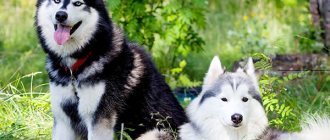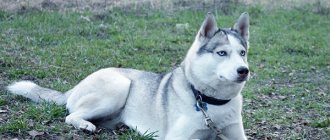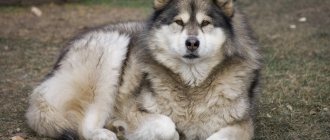Blue-eyed huskies look very unusual, since this eye color is unusual for representatives of most breeds.
In dogs, it is usually found with a marbled color, which in Siberian Huskies is considered extremely rare and atypical for representatives of this breed.
How did it happen that almost all huskies have sky blue or light blue eyes? And why are they more often found in combination with black, gray, brown colors and only rarely in dogs that have a white color?
And what exactly, according to the breed standard, should a husky's eye color be?
Blue-eyed dogs - breed standard
Most often, huskies have eyes of a cool sky blue shade with a dark black outline. Owners of this look are usually dogs with black and white, gray and white or gray coat colors. Pure white huskies with bright eyes are a rare occurrence; becoming the owner of such a dog is considered real luck.
Many people strive to buy a dog with a blue tint to the iris, because this phenomenon is rare in the animal world. Husky is practically the only breed whose standards allow the appearance of such individuals.
Scientists explain the unusual “icy” look of the husky by the special structure of the genes: in blue-eyed individuals, a doubling of a genome section on the 18th chromosome was discovered.
Weimaraner
companion dogs. They are great with children" style="display: block; margin: auto;">
The Weimaraner is known for its sleek silver-gray coat and loving, active personality. Their kind eyes can be amber or blue, which perfectly complements the breed's iconic silver-gray coat. These happy, energetic dogs were bred in the 1800s in Germany for hunting and became popular as
companion dogs. They get along great with children..
Different iris color
The breed standard is not limited to just the blue tint of the iris. You can often find Huskies with deep brown or black looks. As a rule, such individuals have a more saturated coat color, for example, black with splashes of white. Huskies with warm brown coats often have reddish-amber eyes. Sometimes there are representatives of the breed with olive-colored eyes.
Despite the fact that many strive to become the owner of a dog with blue eyes, brown-eyed individuals are considered more practical. The sky-hued iris is more sensitive to light. In conditions of frequent and heavy snowfalls, you can notice that blue-eyed huskies are constantly squinting their eyes. In addition, it is believed that individuals with a dark look are more resistant to disease.
Close to wild nature
A little more attention can be paid to wolf gray. This coloring really makes the dogs look like their closest relatives in nature. Warm gray wool is typical; splashes of red and yellow are allowed. As a rule, pigmentation appears behind the ears, in the back of the head, forearms, shins, hocks, neck, and thighs. Only beige color is allowed for the undercoat. Pigmentation may be darker.
Cynologists also send their rave reviews to the sable color. The coloring is quite interesting. It combines gray, white and coffee tones. Due to its unusual color, this coloring is considered exceptionally beautiful. You don't see her very often. There is a brightly colored undercoat. As a rule, it is a copper-red or tan color. It is the rarity and unusualness of the colors that attract dog handlers and potential owners to this breed. Pigmentation can be very diverse, even chocolate tones.
Odd-eyed dogs
Another rare phenomenon found in this breed is heterochromia, in which the organs of vision have different colors: one is blue and the other is brown. There are two varieties of this phenomenon:
- complete heterochromia implies a pure shade: one eye is completely dark, the other is completely blue;
- with sectoral heterochromia, two colors can be mixed even in one iris: a blue eye will include brown inclusions.
Due to the desire of dog breeders to show off an unusual individual, Husky puppies with heterochromia of the visual organs are often sold at a higher price, although otherwise they are no different from other representatives of the breed.
What is the name of?
Heterochromic Huskies are nicknamed "Harlequins". Such odd-eyed dogs are of particular interest at exhibitions and become a source of pride for the owner. It is believed that the appearance of an unusual dog in the house necessarily promises happiness and good luck.
Normal or defective breed?
Congenital heterochromia is considered completely normal for Huskies. Dog handlers do not associate different eye colors with the presence of diseases or other characteristics of the body. In this case, the pet’s extravagant look should not cause concern.
Phenomena such as clouding of the iris or the appearance of swelling in the area of the pet’s eyes should alert you.
Why different?
Hereditary heterochromia is most often associated with a deficiency or, conversely, an excess of melanin , a natural substance responsible for the intensity of color. Another reason for this phenomenon may be the crossing of two individuals with different eye colors.
But acquired heterochromia also occurs, when a change in the color of the iris becomes a consequence of an illness or prolonged treatment with potent drugs. An arbitrary change in color may indicate the presence of a pathology of the organ of vision or other serious problems with the dog’s health.
If you notice that the color of your Husky's eyes has changed, take your pet to the vet immediately to determine the cause of this phenomenon.
Characteristics and Features
They are distinguished by increased intelligence and have an affinity with wolves. They show stubbornness. The main thing is proper training, then it will be easy for you to find a common language. The husky barks little and does not annoy its owners at all. They have the ability to make unique soft sounds when the dog is in high spirits. They will be grateful to you for your good treatment and will give you all their tenderness and loyalty.
These dogs have very sensitive eyes, so pay special attention to the health of their visual organs. To keep your pet healthy, you don’t need to make extra efforts. They are neat and easy to clean on their own. Twice a year, increased shedding occurs when the undercoat is renewed.
They do an excellent job with their fur on their own. You need to trim the dog’s claws and take care of its paws. Take your pet out into the fresh air more often. They are shown an active lifestyle. Initially they were harnessed to harnesses. So the animal has more than enough energy. We need to give him the opportunity to get rid of her. When a period of intense heat begins, it is better to reduce the time of walking, because such weather is unpleasant for the animal. They are curious. During walks, make sure that the animal does not run away.
Photo
Further in the photo you can see white and other colored adult dogs and husky puppies with blue, brown and different eyes.
Australian Shepherd
<
Merle-colored Australian Shepherds are more likely to have impressive light blue eyes. These dogs are generally more likely to have a combination of blue and brown eyes. The Australian Cattle Dog is brilliant, full of energy and excels in agility competitions. They are best suited for an active home.
When is coloring determined in puppies?
Almost all huskies are born with bright blue irises. Newborn puppies begin to open their eyes around the 20th day after birth, and the retina completes its formation on the 21st - 22nd day.
At about six months of age, the color of a husky's eyes begins to change and does not always remain blue. Therefore, when purchasing a puppy under the age of six months, you cannot be absolutely sure of the pet’s future color.
Husky eyes are the hallmark of this breed. By deciding to become the owner of a husky, you will get yourself a friend with soulful blue or deep brown eyes. Or maybe a real “harlequin” will settle in your house.
Most common colors
Huskies with different eyes are actually not that rare. The color of the iris directly depends on the standard that applies to a particular breed. The most common shades for purebred huskies are the following colors:
- blue;
- brown;
- multi-colored.
Huskies with different eyes are not a disease
For your information! Husky eyes cannot be a rich shade of green. A greenish tint is extremely rare and most often is more of a marsh or olive color. The appearance of other colors indicates that the dog is not purebred.
Blue eyes
Huskies with blue eyes are the most common variation and are the standard. Until a certain point, this color was considered defective, since experts thought that blue, almost white irises were a sign of poor vision or even blindness. Of course, this opinion was wrong. However, the blue color of the iris was not specially bred for a long time, so you rarely see it among northern representatives.
Much later, breeders began to specifically cross blue-eyed dogs, which became a sure sign of purebred dogs.
Externally, the eyes look attractive and frightening. The iris is surrounded by a light stripe, making the shade appear brighter. This feature is associated with genetic abnormalities. In this case, no harm is caused to the dog's health.
Note! A puppy born with blue eyes remains that way for life. The shade does not change and does not darken
Lack of pigment in the iris does not affect visual acuity.
Blue-eyed dogs are the most spectacular
Brown-eyed
Huskies with brown eyes are not that common. At the same time, brown-eyed color does not have to be brown. It can range from honey to black. Externally, the color is quite bright, deep and rich. This is because in this case there is enough pigment.
The color of the fur has no effect on the appearance of a brown iris. Brown-eyed puppies can appear in owners of either black or gray or red fur. However, they are found in greater quantities in chocolate and red shades.
Green irises
As already mentioned, there is no husky with bright green eyes. In fact, green is just a tint or an indicator that the dog is not purebred.
For your information! Marsh or amber shades are often found in dogs with light, ash or gray fur.
Gray
A gray tint occurs, especially in dogs with light fur. At the same time, most experts are inclined to believe that this is not a separate color, but only a variation of a blue tint.
This can also happen due to a mutation, due to which the puppy has gray-blue colors. Albino huskies mostly have gray eyes, again due to a lack of pigment.
Historical reference
Representatives of this breed appeared several thousand years ago. They were brought out by the Chukchi, who inhabited the territory of North-Eastern Siberia. Since these people did not write down their history and kept themselves apart from other peoples, more precise dates for the appearance of the first huskies could not be established. It is possible that the purity of the breed was preserved due to the fact that the Chukchi lived far from civilization.
In the first half of the 20th century, American gold miners who participated in dog sled racing acquired several dozen dogs they liked. This is how the first huskies came to the USA and helped save the breed. These animals were brought to Russia from the Czech Republic and Belgium. This only happened in 1995. Since foreign breeders paid more attention to the exterior rather than driving performance, today these friendly dogs do an excellent job as a companion and just a pet.











